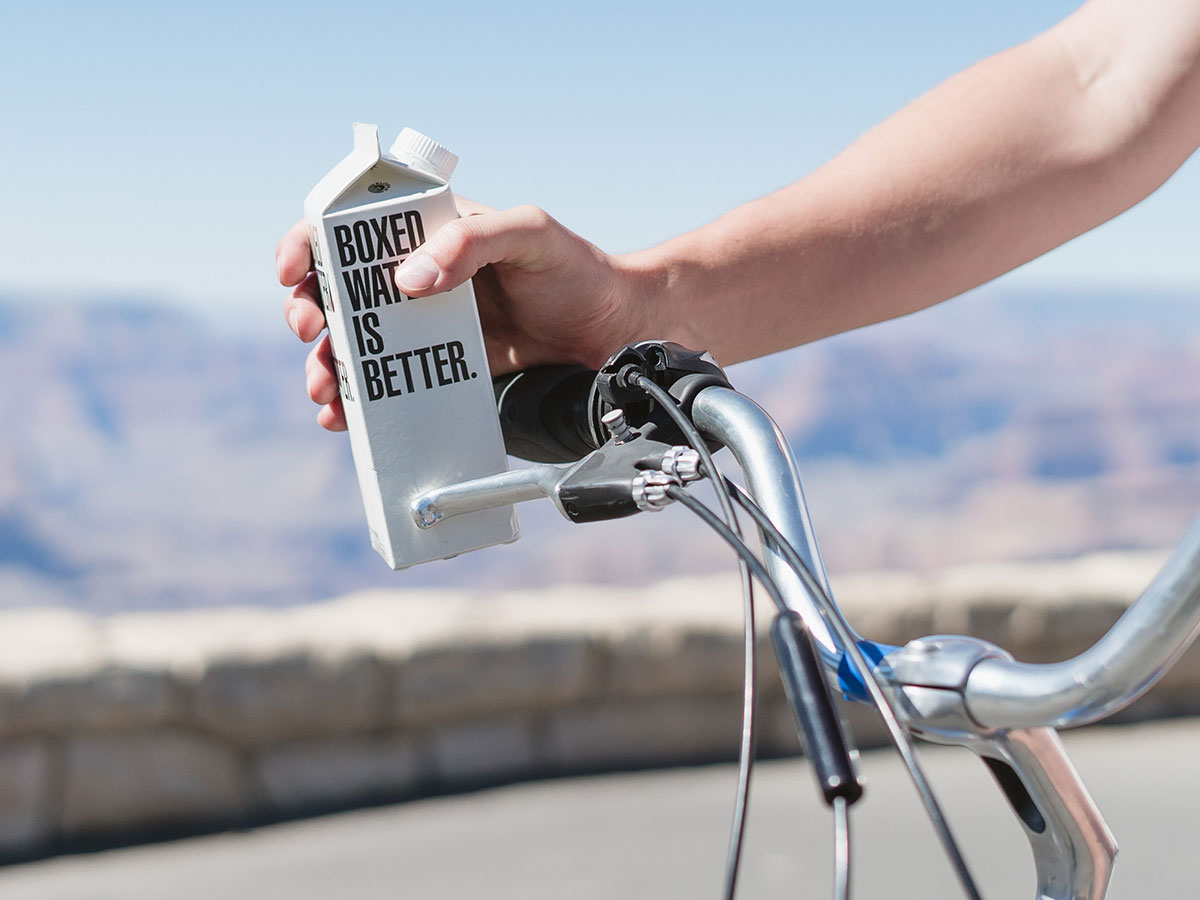Like the word ‘brand’ itself, the brand story can seem like a nebulous, if not ephemeral, concept. Is it a story that tells customers why they should buy from you instead of your competition? Well, not exactly. Is it a story that makes you out as a hero combating local hunger, thus generating goodwill with consumers? Well, it could be.
But mainly, your brand story is the ongoing saga you tell customers about who you are, what you believe in, and what you have to offer. It can take shape over several years through various mediums: blog posts, videos, white papers—the possibilities are nearly endless.
But why should you care about telling good stories?
Because they can set you apart from the competition, which can mean more money in your pocket.
More and more, consumers want to connect with the companies they buy from. They want to see the human side of the company. They don’t want to buy from nameless corporations.
In this post, you’ll not only learn what a brand story is, but you’ll also discover several top-level techniques for telling engaging stories that will have fans coming back for more. Read on.

Why Branding is Key
Before we look at storytelling in-depth, let’s review why branding is paramount. Strong branding does three things for you:
• It improves recognition
• It creates trust
• It supports advertising efforts
Below, we’ll look at these in more detail.
#1 Branding improves recognition
As the face of your business, your logo design is a crucial component of your brand. Your logo design is the one branding component that is instantly recognizable. Think of some of the most iconic logos: Nike, Starbucks, Apple, McDonald’s, Mercedes, Pepsi Co. All of these companies have relatively simple logos that are easy to remember.
If your logo design conveys the values you hold as a company, consumers will remember it and will, in turn, associate you with those values. Your logo should be simple enough for consumers to remember easily, yet powerful enough to make a strong impression.
#2 Consistent Branding Builds Trust
As competition increases, customer trust becomes ever more important. One way that you build this trust is through powerful, consistent branding. This goes beyond your logo design, of course, and it encompasses everything from publishing quality online content to advertising with integrity. Building trust through branding is an on-going, long term effort, but the rewards are well worth it.
In decades past, consumers may have had two or three options when it came to a particular product. But modern consumers have more choice than ever. The world is ever changing—all the more reason to provide some stability to consumers’ lives through consistent branding. Again, we can look to Nike for inspiration here.
It’s the company that presents a consistent brand story that will come out on top.
#3 Branding Supports Advertising
Finally, strong branding is good for your bottom line. As you build recognition and trust, you’ll find that you rely less on on-going advertising campaigns. Word of mouth is powerful, and the goal is for your most loyal customers and brand ambassadors to advertise for you. Naturally, this isn’t a situation you can set up overnight. Indeed, it often requires a substantial investment in time and energy to become an authority in your space, but the long term benefits are substantial.

Why You Need a Story
Think about the last time you met someone you were interested in. You probably wanted to know more about their past. Where did they grow up? You might also want to know about their career or their favorite hobbies. You might ask about their family, too. During that get-to-know-you process, you might feel several emotions:
• Surprise
• Admiration
• Awe
• Anger
• Joy
• Sadness
• Nostalgia
As the new acquaintance shares their history with you, you experience the story with them vicariously. You feel a certain excitement or anticipation. The same thing happens to consumers—naturally, to a lesser degree—when they learn about a company or a new product they may be interested in.
Any number of questions may come to mind, such as:
• How long have they been in business?
• What are the owners like?
• Where did the product idea come from?
• What is the product made of and where is it manufactured?
A savvy business will satisfy this curiosity by telling a compelling brand story.
Let’s review a few short brand stories and the emotions they may conjure:
• Colonial Harland Sanders started KFC at the age of 65, proving that you’re never too old to succeed.
• Paul Mitchell started his hair care product company with his last $700, while homeless—he went from homeless to running a billion-dollar company.
• Warby Parker is at the forefront of the socially-conscious business movement, offering designer eyewear at a revolutionary price while running several philanthropic programs.

What is a Brand Story?
Many new business owners come to this thinking that a brand story is the history of the company. Or else, they think that ‘brand story’ is whatever they come up with in their latest marketing meeting. Both elements can indeed form an important part of a brand story, but the reality is that it’s much bigger than either of those things.
A brand story is a cohesive, consistent narrative encompassing:
• The need you satisfy with your product or service
• The feelings you generate in consumers when they use your product or service
• The truth about who you are as a company
• The values you uphold
Unlike advertising, which is about generating consumer purchase intent by highlighting features and benefits, a brand story is about generating a broad spectrum of emotions with the intent of creating a bond between the consumer and the company.
Recall the following emotions from the list above:
• Surprise
• Admiration
• Awe
• Anger
• Joy
• Sadness
• Nostalgia
Why would you want to make potential customers feel anything in particular?
Because if you create these emotional states in your potential customers, they’re more likely to remember and trust your brand, which will lead to less reliance on advertising. But more broadly, a strong, consistent brand strategy will keep you top of mind in your space and will keep customers coming back.
Here are a few things that can influence your brand:
• Your product
• Your pricing
• Company history
• Product quality
• Your marketing
• Customer experience in your physical or online store
• Values
• What people are saying about you
Keep this list in mind as we go over specific strategies in the next section.

Story Telling Techniques & Tools for the Savvy Business Owner
As mentioned, developing a brand story is a long-term endeavor. You’ll pick up strategies along the way that make it easier and more effective. But we’ve done the hard work for you in collecting this concise list of tips, tricks, and strategies that will make your journey to a compelling brand story that much easier.
The most successful companies in the world have all used these strategies at one time or another, and you can combine them for truly stellar results.
#1 Know Your Medium
Sometimes, it will make sense to publish written content. Other times, video is the way to go. But an unfocused, willy-nilly campaign won’t get you far. When creating content that tells your brand story, you should always know why you’re using a particular medium.
In very broad terms, video and images work well with millennials, while long-form written content works well with older audiences. But this is hardly a hard and fast rule. Use the written word when you need to convey complex information and are including lots of references. Long form, written context is incredibly useful for establishing authority. Use video when you want instant engagement. Though it’s worth noting that you can certainly use video to educate as well, and many companies do so.
As of 2019, YouTube is the undisputed platform for video content. The site receives over seven-billion global views per month and the is the second most popular search engine in the world, second only to Google itself.
Another powerful contender is Vimeo. This platform requires some upfront investment but offers several advantages:
• Less fluff to compete with
• An arguably cleaner layout
• No ads—Because the site is supported by content creators, there are no annoying ads before your video starts
• Password protection—build exclusivity into your videos by putting some of them behind a password. Reward your most loyal fans and supporters with exclusive content.
More and more, Vimeo is being adopted by business owners. After all, does organic traffic to your video really matter if those people are just looking for cat videos?
For long-form written content, Medium can be a powerful ally. The site allows you to create user-friendly content that looks great with minimal effort. Worry less about formatting and more about creating quality content. If you prefer to keep things on your own domain, WordPress, powered by a professional custom theme, remains a viable option.
Finally, keep in mind that technology is advancing all the time. In the 2018 Olympic games, for instance, several companies, such as NBC, Intel and The New York Times, debuted virtual reality applications that allowed them to interact with consumers in new ways. You will need to keep up to date with these new mediums.
#2 Know the Key Elements of Story
However, effective storytellers don’t let the medium set the tone or distract from their message. Whatever the medium, the fundamental elements of powerful stories remain the same. You have:
• Character
• Setting
• Plot
• Conflict
• Resolution
If your story is missing any of these elements, you’ll lose the audience because you’re not actually telling a story.
Note: while conflict is not more important than, say, plot or character, it’s pretty darned important. No conflict, no story.
Imagine that Coke wanted to profit from one of their most notable miss-steps, thus turning a loss into a win.
Consider the New Coke debacle.
Where is the conflict?
Arguably, the conflict stems from the fact that Coke seemed to be out of touch with what their customers really wanted—a classic Coca-Cola experience.
Now jump to the resolution or the takeaway:
Coke demonstrates through the story that they have a renewed commitment to staying in touch with what their fans really want. In the process, they also garner goodwill with consumers by demonstrating that they’re not above poking fun at themselves.
The plot, setting, and characters are important, but if you don’t have a clear idea of the conflict, you won’t grip your reader or viewer. It’s that simple.
Craft your brand messages with this in mind: your story must have conflict, and it must have a satisfying resolution.
You can also use this storytelling technique to entertain an audience while leaving them with a positive impression of your brand. To use Coca-Cola again, think back to those cute Coke polar bear ads. In each one, you had a character trying to achieve something. From that effort stems the conflict, and the character overcoming the conflict leads to a resolution. Coca-Cola entertained the audience and left them feeling all warm and fuzzy, and they probably left them with a more favorable opinion of the company in the process.
#3 Tell Unique, Valuable Stories
“People don’t really tell you this, but often the amount of time finding the decent story is more than the amount of time it takes to produce the story.” —Ira Glass, host of This American Life
Ira Glass, who has hosted This American Life for more than twenty years, spends more than half of each week finding stories for the show. The work of actually producing the show is secondary to finding something to talk about. Think about that.
Consumers are inundated with content—and a lot of these stories are actually just marketing messages disguised as content. But if you can rise above this temptation—if you strive to find and share the info your customers actually want, then you can step well ahead of your competition.
Even if all you do is curate other people’s high-quality content, you will become a resource for consumers if you do it consistently. But ideally, you want to create your own stories. With that in mind, consider the following:
You know you have a unique story that will grab the attention of it’s an “est.”
• It’s the biggest
• It’s the latest
• It’s the craziest
• It’s the longest
These stories have a high potential to gain traction on social media.
#4 Know Which Types of Content Are Performing Well
When considering which type of content to create, consider the ‘why,’ the ‘what, and the ‘who’ first. Why are you creating content? What do you want to achieve, and who is it for? Always plan your content with these questions in mind. Every piece of content you publish should have a purpose. Don’t publish just because you can. What type of content does your audience want?
You can use a content analyzer like BuzzSumo to find out. These tools work kind of like search engines. You give them a keyword, and then they crawl the most popular social media sites to see what type of content people are sharing around that keyword.
Before the advent of Buzzsumo and similar tools, finding out what was performing well was a much more labor-intensive process that involved looking at comments, traffic estimates and other indicators of engagement.
But by using a tool like Buzzsumo, you can find out how to satisfy your audience in a fraction of the time.
The importance of knowing what your audience wants cannot be overstated. Specifically, look for the questions that your customers have—not necessarily about your product or service, but more so about your niche or industry. Look for their problems.
Then create content that fills those gaps.
But don’t just give them the answer. Find subtle ways to weave in information about your brand story—your company history, your values, your product or your service.
#5 Ask Questions
This is one of the oldest tricks in the book, but it works. The human brain is hardwired to sit up and pay attention when it hears a question. All effective stories posit questions to the reader, either directly or indirectly. Going back to elements of the story, we can see that the core question in any story is, ‘Will the protagonist gets what he/she/it wants?’
In other words, will they overcome some sort of antagonist, working through the conflict, to succeed despite the odds?
If your story posits such a question, you will hook the reader or viewer.
As a business owner, you may phrase it more like, ‘Will the customer solve their problem by using my product?’ The more obstacles you put in front of the protagonist of your story—conflict—the more interested the reader will be.
When creating new content, ask yourself:
• Who should care about this? What does your reader have in common with the protagonist?
• What do they stand to gain by reading or watching?
• Is there any urgency? Is the story timely? Does it still matter?
Your story should always have a ‘so what?’ The story must be relevant to the target audience in some way, and there should be urgency. The reader should be able to take some sort of action after reading, and that action should benefit them in some way.
#6 Collaborate
Think about it. There are bound to be many companies—who are not direct competitors—who share your values. When you collaborate with them, you can leverage their social media presence, their brand ambassadors and the goodwill they have generated with the community.
What to collaborate on? Anything, really. But organizing a joint charitable event is always a go-to, and cause-related marketing is very effective. Giving to charity adds to your brand story as it demonstrates to consumers that you aren’t all about the bottom line.
Not only will the event create a lot of good material for your blog and website, but by collaborating with someone else, you’re guaranteed to get your name onto other blogs as well.

Staying Top of Mind
Once you’ve put these techniques into practice and are reaping the rewards of increased customer engagement, you’ll want to keep things going. To do that, you’ll need to remain relevant. In this section, we will explore several ways you can do just that.
#1 Stand Out From the Crowd
Remaining visible is key. The best way to do this is to routinely publish quality content. But you should also cultivate relationships with brand ambassadors who will give you valuable word-of-mouth advertising. Additionally, you should identify your best performing social media platforms and put extra effort into standing out on those.
#2 Always Strive to Establish an Emotional Connection
All of our buying decisions are at least somewhat influenced by emotion, if not outright driven by it. In order to become a mainstay in your industry, you must create an emotional bond with your customers. Audiences want to be entertained, but they also want to be inspired. What’s more, consumers look for opportunities to buy from companies who seem to share their values.
#3 Be Consistent
If you have an irregular posting schedule, jump from medium to medium randomly, or have a newsletter that you publish only once a quarter, you may have a problem with consistency.
Consistency is crucial if you want to stay top of mind. Naturally, if you don’t get yourself in front of potential customers on a regular basis, they won’t think of you when it comes time to make a purchase.
Consider using a task manager like Amazing Marvin or Things, and if you don’t already, use project management software like Asana to manage your content schedule.
#4 Make Your Mark
A tagline or slogan is a powerful way to stay top of mind. Your slogan is uniquely you. When you use it, you remind the customer who you are and what you’re all about. Think of it as a way of quick-loading this information into the prospect’s brain before you interact with them. Why is this important? Because if you’re about to entertain them or provide them with value, you want them to know who you are. This creates a positive association in their mind.
Remember Coca-Cola and their polar bears?
To give you an idea of what a powerful slogan looks like, consider this one from Dollar Shave Club:
Shave time. Shave money.
#5 Build Your Email List & Use it Responsibly
As social media platforms like Twitter, Reddit, Medium and others provide business owners with more ways to keep in touch with their customers, these entrepreneurs are in danger of losing sight of how crucial a robust email list is. An email list allows you to send direct messages to your customer’s inbox. It’s an incredibly powerful tool, and you should strive to build your list at all times.
At the same time, make sure you send messages that are packed with value. If all you ever send is purely promotional messages, you’ll end up in the dreaded Spam folder. What’s more, Gmail and other email providers have made it easier for customers to down-regulate messages they don’t care about. For instance, Gmail provides a “Promotions” tab. Customers can drag your message into the “Promotions” tab and Gmail will send your messages to that tab forever more. At that point, the customer probably won’t ever open another message from you. You’ve lost them.
I hope this concise guide has helped you hone in what a brand story is and how to create one that will propel you to greatness. What are some of your favorite brand stories? Let me know in the comment’s section below!
« Is Cause-related Marketing for You? Find Out How Your Non-profit Can Benefit From Partnering With Corporations | Avoid Growth Hacking and Embrace Brand Building »

